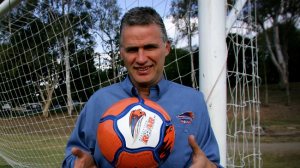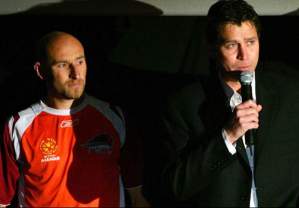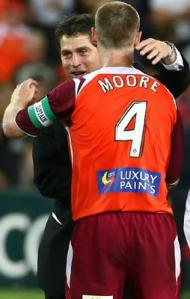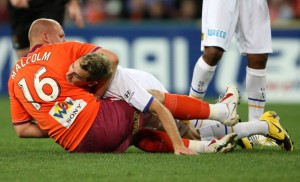Since Ange Postecoglou and his knack for rebuilding football squads is the talking point of the Socceroos at the moment, I thought I’d write something about his original masterpiece: Rebuilding the Brisbane Roar.
But in order to compare the Socceroos transformation to the Brisbane revolution, the history leading up to Ange’s takeover must be told. This is a full piece detailing the turmoil behind the Roar prior to and after Ange taking the reins of (at that time)the A-League’s biggest underachievers
Part 1 is the story of the state of the Roar prior to Ange taking the reins.
Part 2 is the story of the purge.
Part 3 is the story of Ange’s new dynasty.
PART 1. The Farina Days.
Frank Farina took over the management of the club from Miron Bleiberg to the delight of the local punditry. The last and only person the lift the NSL trophy north of the tweed, Farina was seen as the person to give the club some publicity amongst the saturated sports media whilst improving the club’s on-field performances.
To be fair, Bleiberg’s first and only full season was completed with what was essentially the local league’s all conquering Qld Lions. They were the Man City of Brisbane football. They had the cash and bought the best local players. Lions dominated Brisbane football.
When the tender went out from the newly formed FFA for a Queensland A-League franchise. Lions were the best option ahead of a Brisbane Strikers outfit backed by former Brisbane Lord Mayor Clem Jones.
Out of reward and loyalty for Bleiberg’s performance as coach of Lions, he was offered the opportunity to be the club’s inaugural A-League coach. The players knew him, the back room staff knew him, it was just a promotion for the entire club to the new division. Best to leave the furniture in-tact and make arrangements later.
To be blunt, Brisbane’s first season was not sparkling finishing 6th in an 8 team competition. The board began to realise that if they wanted success in the new National League, what guaranteed success at city level wasn’t going to cut it in the new league. After only a handful of games into season 2, Bleiberg resigned as coach.
Local media jumped at the opportunity to push Frank Farina forward as the only viable option to lead Brisbane Roar. Farina was out of work after being pushed aside as Socceroos coach for Guus Hiddink a year earlier and was eager to rebuild his coaching reputation.
Farina’s success as Socceroos manager can and will be debated at length for years to come, but one field of football management he is undoubtedly excellent in is identifying young talent and promoting it in a fashion that it shines brightly.
Over the next seasons the following young talents would take the field for Brisbane Roar under the tutelage of Farina: Robbie Kruse, Michael Zullo, David Williams, Mitch Nichols, Tahj Minniecon, Adam Sarota, Ivan Franjic, Luke De Vere & Luke Brattan.
Farina also maintained his international connections, and in mid-2007 announced a coup for Brisbane Roar signing Socceroo internationals Craig Moore from Scottish powerhouse Glasgow Rangers (as Brisbane’s first marquee player) as well as Danny Tiatto from Manchester City and later Leicester City.
Farina got down to business in 2007/08 (his first full season) organising his team as a very well structured one. The club gained a major sponsorship from The Coffee Club (which remains as of this day) as jersey sponsors. Grinding out results and slowly, but surely, climbing the ladder to be top of the table going into the final round needing a win away at Adelaide to secure the Premiership.
In what will forever be known by Roar fans as “the kit debacle” the Brisbane squad traveled to Adelaide with their orange home kit instead of their white away jerseys and the match (and season) disintegrated before their eyes, losing the game 2-0.
Despite qualifying for the finals for the first time, it was bitter consolation as the Roar were topping the table for much of the season.
It was at this time that Craig Moore was beginning to have more of an influence over the club than anyone else in the organisation. Because of his experience in international football, he was the alpha male in the playing group. He maintained his close friendship with Farina (stretching back to while both were in the Socceroos set up), and now he was bearing a major influence on operational matters – especially who to sign.
Next season saw some foreign acquisitions join the club: Charlie Miller and Sergio Van Dijk.
Miller was a friend of Moore’s from when they played together at Rangers in the 1990’s.
2008/09 was similar to the previous season: Largely unfulfilled potential resulted in Brisbane Roar finishing 3rd, 2 points away from the premiership despite having some bright patches. In the background, a new ownership group took control of the club comprising of directors of The Coffee Club and Luxury Paints – who were both current jersey sponsors.
Next season shaped up a little differently. Two new Queensland clubs changed the dynamic in Brisbane. Bankrolled by Clive Palmer, Gold Coast United joined the league with former Brisbane Roar coach Miron Bleiberg who was out to prove his worth, and a Socceroo marquee of their own, Jason Culina, straight from Dutch champions PSV Eindhoven.
The pressure was on Farina and the Brisbane team to deliver the goods. Moore had again been instrumental in recruiting Bob Malcolm, another mate from Rangers days. Assurances were made by Farina to the board that he was confident the team was ready for a productive season.
The first match of the season was the new South East Queensland derby. Farina & Bleiberg duly talked the game up, but on the field it was a demolition. The new boys tore the established to pieces.
The board were irate. Farina was already on thin ice. An entire pre-season looked to have been wasted.
Reports made their way to senior management that junior players were intimidated within the playing group. Some of the younger players I know had told me that they feared being picked out in a training session for special treatment if they did so much as looked at someone the wrong way.
Moore had built up his cabal within the playing group (including Moore, Miller, Malcolm, Tiatto and Liam Reddy) and through his friendship with Farina, his clique could act with impunity because Farina would not act against his club captain, his most experienced player, his friend. Farina’s power had been usurped by Moore who essentially had complete control over the club.
It was this intimidation that helped Robbie Kruse depart for Melbourne Victory. Stifled by the team environment, Kruse’s on field performances were negatively affected and his growth as a professional footballer had stalled.
Robbie Kruse would get to face off against his former club in the second round. Robbie Kruse would also feel the retribution from Charlie Miller who elbowed Kruse off the ball (but not off camera) and would be suspended for it.
Morale within the playing group fell to new lows. The squad outside of the cartel – especially the junior players – were dissatisfied with the way the club was progressing. One of their friends from last season was given a going over for no reason.
The board had had enough. The atmosphere within the club was toxic. The new Gold Coast United club was at the top of the table while the Roar were struggling. They were ready to cut Farina loose but couldn’t afford to pay out his considerable contract.
Then in October the board’s prayers were answered. Farina is charged with drink driving, his second offence. They now have reason to sack him without breaching his contract. But ridding themselves of Farina is only half the problem. The club itself has become infected with the Moore virus.
By the end, Farina had become “one of the boys” among the senior players. He attended parties and bbq’s with players. He had lost all authority and was essentially a part-time manager of a team on auto-pilot. His decline was inevitable – he just brought it on earlier than planned.
Comparing the situation in Brisbane to what Postecoglou found upon taking control with the Socceroos was a little different in that the atmosphere within the Brisbane playing group wasn’t as toxic given it was a national team and players could return to their more comfortable club surroundings when not on National Duty.
Most senior Socceroo players were heroes from the golden generation and were bankable in the marketing stakes for FFA, and they knew it. They weren’t going to be pushed aside easily without their consent, especially from a foreign coach who was more expendable than they were.
That being said, the on-field results for the Socceroos were far worse than what Brisbane Roar were achieving. The Socceroos dismal World Cup qualifying and slide down the rankings set off alarms ahead of the World Cup and the very important hosting of the Asian Cup. Time is of the essence for our National Team in order to prevent international disgrace.
End of Part 1.












One comment